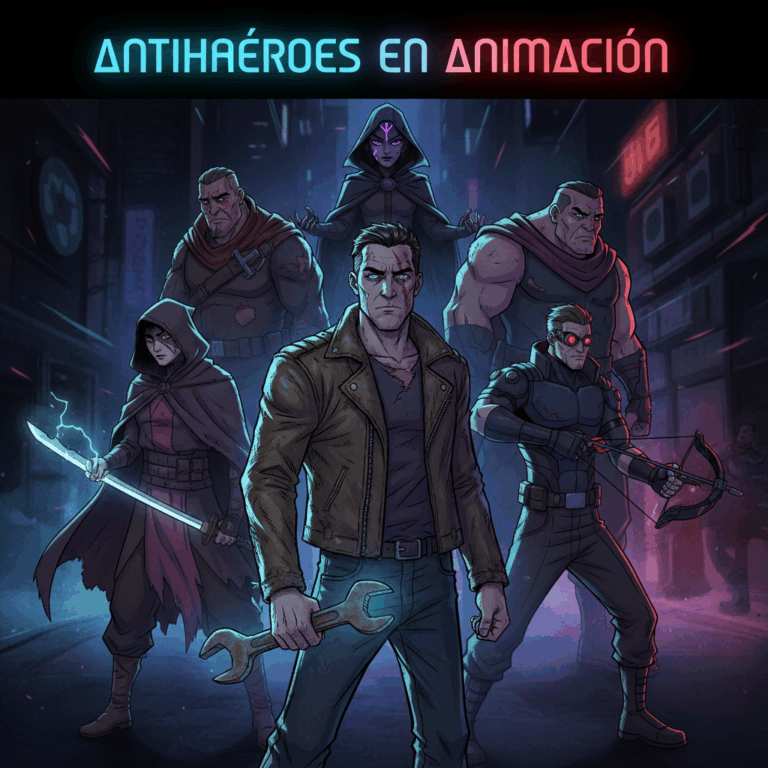Characteristics of antiheroes in animation
The antiheroes In animation, they stand out for their moral ambiguity and behaviors that deviate from traditional heroism.
These characters do not exhibit classical virtues, but are guided by personal interests or complex internal dilemmas.
His humanity is reflected in controversial decisions and behaviors that challenge usual ethical standards.
Moral ambiguity and behaviors outside of traditional heroism
The moral ambiguity It is an essential characteristic, since its values are neither clear nor absolutist, showing gray areas.
They act freely outside of social norms, which may include violence or selfishness, distancing themselves from the heroic ideal.
Their personality is often vulnerable, insecure, or awkward, which humanizes them and creates a complex connection with the audience.
Often his actions do not seek admiration but rather to provoke reflection on human nature.
Contradictions and controversial decisions
Antiheroes make decisions that turn out controversial, often involving questionable or selfish acts.
They confuse the viewer because they can alternate moments of excessive violence with gestures of unexpected heroism.
His behavior reflects internal struggles and contradictions, moving away from the stereotype of the perfect and virtuous hero.
Prominent examples of animated antiheroes
In animation, the antiheroes They stand out for their complex motivations and ambiguous behaviors that challenge the traditional hero.
These characters often have deep internal conflicts and act from perspectives that generate moral debates in the audience.
Its representation in different narrative styles has enriched the animated genre, opening up new ways of telling stories.
Harley Quinn and Venom: complex motivations
Harley Quinn stands out for her shifting morals and personal motivations that oscillate between criminality and fighting against greater threats.
Venom represents a dark and rejected figure, who sometimes acts as a protector, which adds layers to his dual personality.
Both characters display humanity and contradictions that distance them from the stereotype of the pure classical hero.
Kratos: destruction and internal conflict
Kratos is defined by his enormous destructive capacity, guided by a deep internal conflict that causes him doubts and remorse.
His crusade against oppressors has enormous consequences, highlighting the complexity of his character in animation.
This antihero reflects the tensions between personal justice and collateral damage that make him fascinating.
Stain in anime: marginal ethics and questioning the system
Stain challenges the dominant heroic structure with his own ethics, acting from marginalization and criticism.
His speech questions the professional hero system, raising moral tensions in the universe of "My Hero Academia".
This character demonstrates how antiheroes can be both dark and bearers of profound social questions.
Social and psychological impact of antiheroes
The antiheroes They usually face a strong social rejectionbecause their actions and morality distance them from the collective ideal of a hero.
This marginalization It can intensify their internal conflicts, turning them into complex figures that reflect social tensions.
Their presence introduces debates about social acceptance and boundaries, as they represent those who challenge established norms.
Social rejection and marginalization
Antiheroes tend to be feared either excluded by society, even when their actions seek a greater good.
This marginalization This places them in a conflictive internal position, as outsiders who question coexistence and social rules.
They often symbolize the fight against injustice from a marginal position, showing the complexity of social acceptance.
Addictions, obsessions, and traumas
Many antiheroes present traumas and obsessions that influence their decisions and behavior.
These psychological characteristics humanize and deepen their image, bringing them closer to audiences that recognize real vulnerabilities.
They also reflect the internal struggles and consequences of a painful past, which shape their motivations and actions.
New narratives and empathy in animation
New narratives in animation explore the moral complexity of anti-heroes, moving away from the binary view of good and evil.
These stories invite the audience to empathize with imperfect characters, reflecting real human dilemmas and conflicts.
Thus, animation is enriched with storylines that show the multiple dimensions of character, promoting a deeper and more human vision.
Exploring moral complexity
Current animation investigates the ambiguity and ethical contradictions of anti-heroes, emphasizing that not everything is black and white.
This approach allows us to understand their decisions within complex contexts, where motivations and consequences are intertwined.
The viewer is invited to question their own judgments, recognizing the moral diversity and internal conflicts present in these characters.
A reflection of human contradictions
Animated antiheroes reflect the contradictions and ambivalences that many face in real life, with virtues and flaws.
This representation promotes a deeper empathy because it humanizes figures that do not fit into classic heroic stereotypes.
Thus, animation offers a mirror where emotional and ethical tensions are reflected, making stories more relatable and meaningful.






